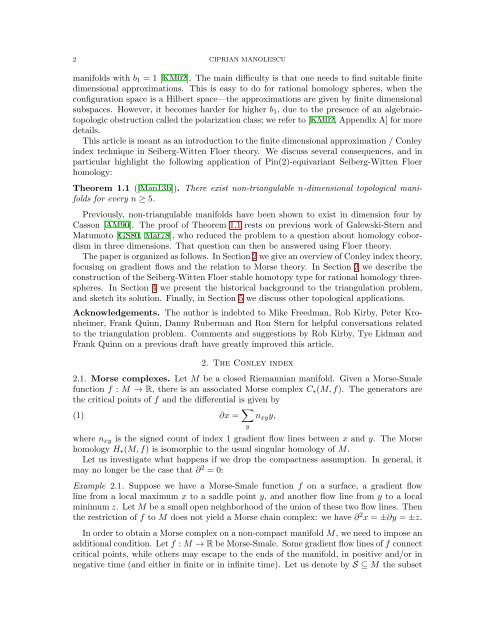The Conley index, gauge theory, and triangulations - UCLA ...
The Conley index, gauge theory, and triangulations - UCLA ...
The Conley index, gauge theory, and triangulations - UCLA ...
Create successful ePaper yourself
Turn your PDF publications into a flip-book with our unique Google optimized e-Paper software.
2 CIPRIAN MANOLESCU<br />
manifolds with b 1 = 1 [KM02]. <strong>The</strong> main difficulty is that one needs to find suitable finite<br />
dimensional approximations. This is easy to do for rational homology spheres, when the<br />
configuration space is a Hilbert space—the approximations are given by finite dimensional<br />
subspaces. However, it becomes harder for higher b 1 , due to the presence of an algebraictopologic<br />
obstruction called the polarization class; we refer to [KM02, Appendix A] for more<br />
details.<br />
This article is meant as an introduction to the finite dimensional approximation / <strong>Conley</strong><br />
<strong>index</strong> technique in Seiberg-Witten Floer <strong>theory</strong>. We discuss several consequences, <strong>and</strong> in<br />
particular highlight the following application of Pin(2)-equivariant Seiberg-Witten Floer<br />
homology:<br />
<strong>The</strong>orem 1.1 ([Man13b]). <strong>The</strong>re exist non-triangulable n-dimensional topological manifolds<br />
for every n ≥ 5.<br />
Previously, non-triangulable manifolds have been shown to exist in dimension four by<br />
Casson [AM90]. <strong>The</strong> proof of <strong>The</strong>orem 1.1 rests on previous work of Galewski-Stern <strong>and</strong><br />
Matumoto [GS80, Mat78], who reduced the problem to a question about homology cobordism<br />
in three dimensions. That question can then be answered using Floer <strong>theory</strong>.<br />
<strong>The</strong> paper is organized as follows. In Section 2 we give an overview of <strong>Conley</strong> <strong>index</strong> <strong>theory</strong>,<br />
focusing on gradient flows <strong>and</strong> the relation to Morse <strong>theory</strong>. In Section 3 we describe the<br />
construction of the Seiberg-Witten Floer stable homotopy type for rational homology threespheres.<br />
In Section 4 we present the historical background to the triangulation problem,<br />
<strong>and</strong> sketch its solution. Finally, in Section 5 we discuss other topological applications.<br />
Acknowledgements. <strong>The</strong> author is indebted to Mike Freedman, Rob Kirby, Peter Kronheimer,<br />
Frank Quinn, Danny Ruberman <strong>and</strong> Ron Stern for helpful conversations related<br />
to the triangulation problem. Comments <strong>and</strong> suggestions by Rob Kirby, Tye Lidman <strong>and</strong><br />
Frank Quinn on a previous draft have greatly improved this article.<br />
2. <strong>The</strong> <strong>Conley</strong> <strong>index</strong><br />
2.1. Morse complexes. Let M be a closed Riemannian manifold. Given a Morse-Smale<br />
function f : M → R, there is an associated Morse complex C ∗ (M, f). <strong>The</strong> generators are<br />
the critical points of f <strong>and</strong> the differential is given by<br />
(1) ∂x = ∑ y<br />
n xy y,<br />
where n xy is the signed count of <strong>index</strong> 1 gradient flow lines between x <strong>and</strong> y. <strong>The</strong> Morse<br />
homology H ∗ (M, f) is isomorphic to the usual singular homology of M.<br />
Let us investigate what happens if we drop the compactness assumption. In general, it<br />
may no longer be the case that ∂ 2 = 0:<br />
Example 2.1. Suppose we have a Morse-Smale function f on a surface, a gradient flow<br />
line from a local maximum x to a saddle point y, <strong>and</strong> another flow line from y to a local<br />
minimum z. Let M be a small open neighborhood of the union of these two flow lines. <strong>The</strong>n<br />
the restriction of f to M does not yield a Morse chain complex: we have ∂ 2 x = ±∂y = ±z.<br />
In order to obtain a Morse complex on a non-compact manifold M, we need to impose an<br />
additional condition. Let f : M → R be Morse-Smale. Some gradient flow lines of f connect<br />
critical points, while others may escape to the ends of the manifold, in positive <strong>and</strong>/or in<br />
negative time (<strong>and</strong> either in finite or in infinite time). Let us denote by S ⊆ M the subset
















